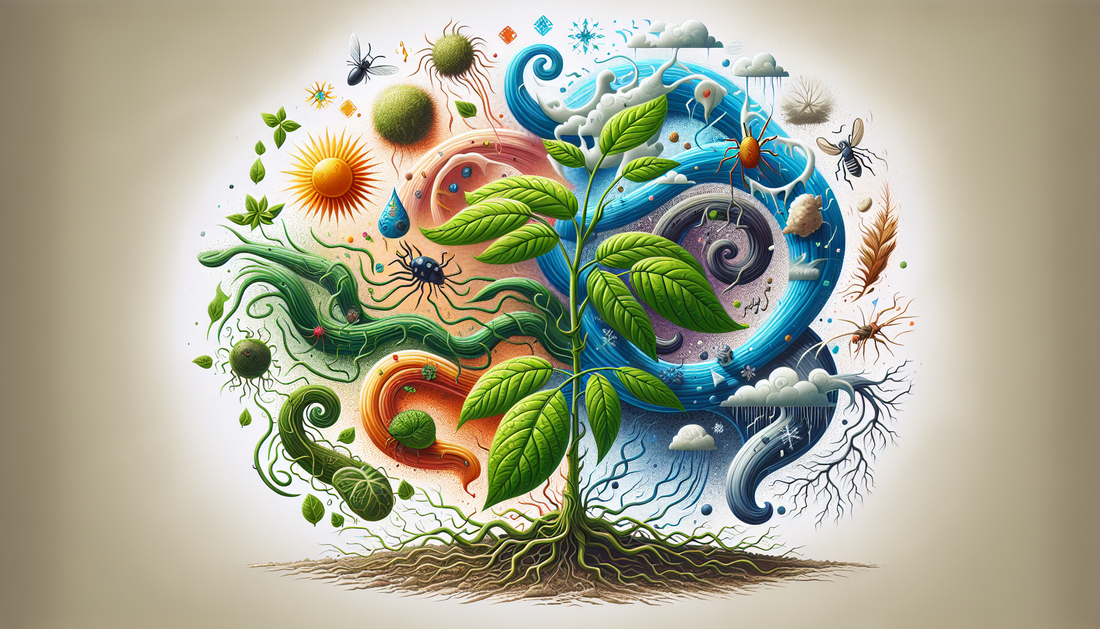
Plant Stress: Understanding, Causes, Effects and Alleviating Growth Challenges
Ever wondered why the once vibrant green leaves of your house plant have turned yellow? If you're curious about what makes your green friends tick (or wilt), then you're in the right place! We delve into the intriguing world of Plant Stress and its implications for our food supply.
In today’s post, we're unpacking the concept of Plant Stress: what it is, why it happens, and how it can lead to bigger problems like food insecurity. It’s not just about droopy leaves or yellowing stems; it's about understanding the silent cries for help from our leafy companions and the ripple effects they can have on our global food chain.
So, whether you're a budding botanist, a concerned foodie, or just someone who loves plants, this post is for you. Let’s dig deeper into the world of Plant Stress and discover how we can nurture our plants for a healthier, more secure food future!
Understanding Plant Stress: Causes and Effects
Plant stress paints an intricate narrative of a plant’s struggle against unfavorable conditions. From the most humble houseplant to the vast expanse of agricultural crops, all plants can fall victim to stress, which can lead to a decline in their health and food production. Understanding the plant stress response is crucial in order to mitigate these negative effects and promote plant health.
The external factors that stresses are categorized into biotic and abiotic stressors, each presenting their unique challenges.
Biotic Stress Factors
Microscopic invaders such as microbes and insects represent the biotic stress factors. They can inflict significant stress on plants, with certain insects like spider mites, aphids, and scales being notably detrimental.
Parasites, including plant parasitic nematodes and plant pests, induce stress by consuming various parts of the plant and interfering with nutrient absorption. Consequently, these biotic factors result in nutritional imbalances that could potentially harm the plant’s health and growth.
Abiotic Stress Factors
Contrarily, abiotic stress factors encompass physical and chemical conditions contributing to plant strain. Some examples include:
-
Drought stress
-
Flood and too much water
-
Salinity
-
High winds
-
Soil compaction
These extreme conditions can significantly reduce yield due to factors like water loss in plant cells and slowed growth. Additionally, chemical stressors such as air pollution, pesticides, and water contaminants can alter the environment in which plants grow and negatively affect their nutrient uptake.
Moreover, both scarcity and surplus of soil nutrients can contribute to plant strain, impacting plant growth and health.
Effects on Plant Growth and Health
Stress undeniably affects the growth and health of plants. The production of primary and secondary metabolites, which regulate osmotic pressure and defend against infection, can be affected under stress elements like low temperature that can lead to cold stress. Silicon, a vital element in plant development, serves to boost plant immune responses and yield, allowing plants to more effectively withstand strains.
Additionally, biofertilizers or biostimulants significantly enhance the crop’s resilience to strain and foster their recovery.
Plant Stress Detection Techniques
Recognition of plant stress holds equal importance as understanding it. Thanks to advancements in technology, we now have an array of detection techniques at our disposal. From remote sensing to molecular approaches, each technique offers unique insights into the health of your plant and strains. However, these technologies also pose challenges, such as the need for correct measurement protocols and the management of environmental condition variability.
For example, machine learning models predict plant strains through anomaly detection, pinpointing anomalies or outliers in real-time data. Additionally, spectral imaging can provide detailed insights by highlighting changes in the plant’s chemical and physical state.
Remote Sensing
Remote sensing plays a crucial part in detecting plant stress. By utilizing sensors that function across various spectral domains, this can identify plant strain without the need for direct interaction with the plants.
The correlation between physiological and biochemical responses to temperature stress in plants, including the production of reactive oxygen species, can be assessed through remote sensing techniques.
Fluorescence and Thermal Imaging
Fluorescence and thermal imaging techniques are also vital in plant stress detection. Fluorescence imaging, for instance, can uncover subtle alterations in the plant’s condition before they manifest as visible symptoms. Chlorophyll fluorescence imaging, a significant tool, plays a crucial role in the early identification of stress responses.
Morphologic imaging techniques offer:
-
Non-disruptive information about the structure of plants
-
Quantitative information about the structure of plants
-
Precise information about the structure of plants
-
Detailed observations of physical changes in plant morphology
These techniques enable researchers to gather valuable insights into plant morphology, plant metabolism, and plant physiology.
Molecular and Metabolomic Approaches
Molecular and metabolomics techniques have revolutionized our understanding of plant stress at a molecular level. Molecular methods like PCR and ELISA allow the analysis of gene expression and protein detection in response to plant strain. PCR, in particular, helps researchers understand the molecular mechanisms that respond to abiotic strain in different plant species.
Meanwhile, ELISA enables the identification of biotic stress in plants by utilizing a specific antibody for a protein (antigen) associated with a plant disease. Metabolomics, on the other hand, provides valuable insights into cellular and molecular adaptations to biotic and abiotic stresses, leading to a comprehensive understanding of a plant’s biochemical state under stress conditions.
Strategies for Alleviating Plant Stress

Enhancing the growth of plant and productivity necessitates the mitigation of plant strains. Various strategies can be employed to manage plant stresses, ranging from agronomic practices to the application of biofertilizers and biostimulants. Notably, silicon and biofertilizers contribute to plant resistance by improving water balance and soil fertility, reducing strain impacts, and increasing stress tolerance to both abiotic and biotic pressures.
In recent years, advancements have been made in developing stress-resistant plant varieties, enabling plant responses to more effectively withstand biotic and abiotic factors.
Agronomic Management
Agronomic practices significantly contribute to the alleviation of plant stress. Proper nutrient management, for instance, is paramount in improving nutrient uptake, increasing crop tolerance to stressors, and enhancing crop quality and yield. Additionally, irrigation management reduces plant strain by ensuring timely and adequate water supply, minimizing drainage, and preventing crop water stress. However, both excessive and insufficient watering can induce strains to plants, leading to conditions that range from waterlogging to reduced fresh mass and nutritionally significant factors.
Furthermore, managing soil fertility through suitable soil and crop management practices can aid in minimizing plant stress and enhancing crop productivity.
Use of Silicon and Biofertilizers
Silicon and biofertilizers present a natural remedy for plant stress. Here are some benefits of using silicon for plants:
-
Reinforces plant tissues
-
Improves disease resistance
-
Regulates the synthesis of plant growth regulators to alleviate strains
-
Enhances plant resistance to stress by increasing root water uptake
-
Regulates root surface and anatomy
-
Improves resistance to diseases
Using silicon and biofertilizers in plant soil can help plants thrive and overcome stress.
On the other hand, biofertilizers improve plant health and soil quality by enhancing soil structure, nutrient cycling, and microbial diversity.
Breeding for Stress-Resistant Varieties
Developing stress-resistant varieties also serves as an effective strategy for tackling plant stress. This practice involves the development of crops that can more effectively withstand biotic and abiotic stress factors, thereby contributing to food security and agricultural sustainability. Some successful examples include Sarnav, which has tolerance to soil salinity and drought, and millets and quinoa, known for their drought-resistant properties. However, the intricate genetic architecture of stress responses makes it challenging to select and breed for these traits.
The Role of Technology in Plant Stress Management
Technology significantly contributes to the management of plant stress. Advanced technologies like precision agriculture and high-throughput phenotyping offer promising solutions for managing plant stresses and improving crop yield. Despite the advantages, there are limitations to employing technology in plant stress management, including a limited range of detectable strain severities, constraints of image platforms, and at times, limited sampling which can impact the effectiveness of the technology.
Precision Agriculture
This technology adopts and optimize the usage of crop inputs like:
-
fertilizers
-
pesticides
-
tillage
-
irrigation
This approach utilizes IoT technology for remote monitoring of growth and health of plants. Automated anomaly detection techniques, such as clustering and dimensionality reduction, are deployed in to identify irregularities that may cause plant strains.
However, despite the advantages, employing precision agriculture for managing healthy plants and strains has its drawbacks, including:
-
Labor limitations
-
Resource management requirements
-
The need for tailored solutions to address distinct challenges encountered in various farming environments.
High-Throughput Phenotyping
High-throughput phenotyping marks a considerable advancement in plant stress management. It allows the nondestructive and noninvasive measurement of complex plant traits in plant breeding. The benefits extend to assessing plant strains, providing new insights for enhancing crops, and a deeper comprehension of quantitative traits in plants.
Conclusion
Stress isn’t just a human experience—it's a green dilemma too! From scorching sun to nutrient imbalances, our leafy friends face their fair share of challenges. Understanding these stressors is like learning the ABCs of plant care. It's about creating harmony between what they need and what the environment throws their way.
Just like us, plants thrive when we listen to their needs. Whether it's proper watering, balanced soil ph, insect pests, or shielding them from extreme temperatures, a little TLC goes a long way.
Ready to become a plant hero? Join our community of green thumbs and budding botanists. Share your tips, ask questions, and cultivate a world where every plant can flourish. Let’s Grow Together!
FAQs
What is the definition of stress in crops?
It is defined as any unfavorable condition or substance that affects or blocks a plant's metabolism, growth, or development. This can be induced by various natural and anthropogenic stress elements.
How do you fix stress in plants?
To fix it, you can use biofertilizers or biostimulants, which increase crop resistance to strains and aid in recovery by stimulating natural processes. These products help plants build resistance against various pressures.
What does a stressed plant look like?
A stressed plant may exhibit yellowing, browning, or wilting leaves, which are early signs of plant strains. Watch out for these indicators to assess the health of your plants.
What is the cause of stress on most plants?
The cause of strains on most plants is primarily due to temperature extremes. High temperatures lead to physiological damage, while low temperatures can halt growth and cause plants to freeze or die.
What are some strategies for alleviating plant stress?
To alleviate plant stress, consider implementing agronomic practices, using silicon and biofertilizers, and breeding stress-resistant varieties. These strategies can help improve the overall health and resilience of your plants.
